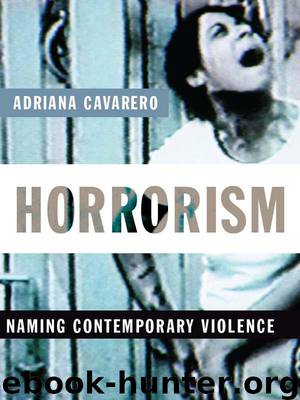Horrorism: Naming Contemporary Violence (New Directions in Critical Theory) by Cavarero Adriana

Author:Cavarero, Adriana [Cavarero, Adriana]
Language: eng
Format: mobi
Tags: Philosophy/Movements/Deconstruction
Publisher: Columbia University Press
Published: 2008-12-14T16:00:00+00:00
14
For a History of Terror
The designation “terrorism” represents an intellectual simplification that is satisfied with spreading a blanket of disapproval over things whose logics we cannot easily discern.
—Gilles Kepel, introduction to Al-Qaida dans le texte
As Townshend notes, the term “terrorism” made its first appearance in the 1798 edition of the Dictionnaire de l’Académie Française, where it is defined as “système, régime de la terreur.”1 Both the neologism and its definition are influenced by the lexicon of the French Revolution, more specifically by the Terreur proclaimed by the Committee of Public Safety in 1793 against the enemies of liberty who were threatening the new republic both externally and internally. But during the two tremendous years that witnessed “the political use of serial death” beneath the blade of the guillotine, the revolutionary patriots directed their terror primarily at the internal enemy, in other words, at citizens of France: unarmed civilians, totaling fourteen thousand victims, of whom “72 per cent came from the same classes that had supported the Revolution.”2 The external threat, on the other hand, continued to be met with the traditional methods of war; in that violent maelstrom, terror persisted as an everyday fact, certainly not as a political category worthy of being distinguished with a capital letter.
Although it was a rhetorical device of revolutionary writing, the importance of that capital letter should not be undervalued. With a certain welcome succinctness, it illuminates the distinction between political Terror and the terror of battle, following a system of correspondences of sorts, in which the place of Terror is the internal sphere of the state and that of terror is the external realm of war. In this system, the terror of battle represents nothing new, being indeed one of its most traditional ingredients. What is new is the state and the Terror that emerges with violence onto the most celebrated of the historical scenes that witness its origin. Born with the state and within the state, terrorism—as one of the categories of its modern classification would have it—emerges into history in the originary form of state terrorism. In this classification, the events in France also mark the onset of so-called revolutionary terrorism, another crucial paradigm for modern history revived principally by the Russian Revolution, in which terror is “an institutional device, consciously employed to accelerate the momentum of the revolution.”3 Given that the Russian case leads precisely to a form of state terrorism, the distinction, at least at this stage of the argument, has little relevance.
Not surprisingly, the lexical contribution of revolutionary France to the history of terrorism finds a significant resonance in the political theory elaborated more than a century earlier by a philosopher prized by Schmitt: Thomas Hobbes, the most lucid and best known of the founding fathers of the modern state as sovereign territorial state. Equally well known is the theoretical construct or, if you prefer, the narrative with which he describes and justifies the artificial genesis of the state or, as he calls it, the “commonwealth.” This construct begins with a war, the war of all against all that characterizes the state of nature.
Download
This site does not store any files on its server. We only index and link to content provided by other sites. Please contact the content providers to delete copyright contents if any and email us, we'll remove relevant links or contents immediately.
| Deconstruction | Existentialism |
| Humanism | Phenomenology |
| Pragmatism | Rationalism |
| Structuralism | Transcendentalism |
| Utilitarianism |
The remains of the day by Kazuo Ishiguro(8821)
Tools of Titans by Timothy Ferriss(8218)
Giovanni's Room by James Baldwin(7191)
The Black Swan by Nassim Nicholas Taleb(7010)
Inner Engineering: A Yogi's Guide to Joy by Sadhguru(6725)
The Way of Zen by Alan W. Watts(6505)
Asking the Right Questions: A Guide to Critical Thinking by M. Neil Browne & Stuart M. Keeley(5633)
The Power of Now: A Guide to Spiritual Enlightenment by Eckhart Tolle(5605)
The Six Wives Of Henry VIII (WOMEN IN HISTORY) by Fraser Antonia(5394)
Astrophysics for People in a Hurry by Neil DeGrasse Tyson(5132)
Housekeeping by Marilynne Robinson(4346)
12 Rules for Life by Jordan B. Peterson(4250)
Double Down (Diary of a Wimpy Kid Book 11) by Jeff Kinney(4207)
The Ethical Slut by Janet W. Hardy(4173)
Skin in the Game by Nassim Nicholas Taleb(4162)
Ikigai by Héctor García & Francesc Miralles(4125)
The Art of Happiness by The Dalai Lama(4063)
Skin in the Game: Hidden Asymmetries in Daily Life by Nassim Nicholas Taleb(3929)
Walking by Henry David Thoreau(3893)
